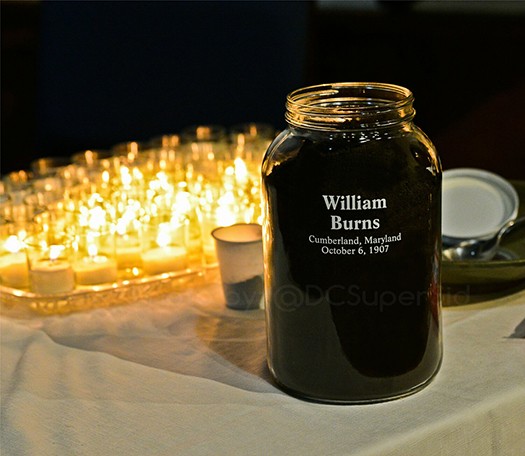“I hope you are prepared to participate in this process because it will certainly involve you,” said Dr. David Fakunle, chair of the Maryland Lynching Truth and Reconciliation Commission (MLTRC), as he opened the commission’s first public hearing in Cumberland, Allegany County, Maryland, on October 2, 2021. The event, broadcast live from Emmanuel Episcopal Church, brought together commissioners, panelists, and guests to acknowledge and memorialize the tragic lynching of 18-year-old Robert Hughes (aka William Burns) in Cumberland in 1907. In the coming months, the MLTRC will convene several more of these public hearings in counties across the state of Maryland.
Lynching is one of the most horrific acts of the dehumanization, racial terror, and injustice committed against African Americans, and it represents a lens through which to examine the legacy of racism in Maryland and beyond. Established with unanimous support by the Maryland General Assembly in 2019, the MLTRC is tasked with holding public hearings in areas of the state where white mobs are known to have lynched African Americans, consulting with descents of victims and members of the affected communities, and making recommendations for addressing this violent legacy.
Commissioners Dr. David Fakunle and Dr. Charles Chavis, together with Clory Jackson and Caroline Hann, who co-lead the Allegany County Lynching Truth and Reconciliation Committee (ACLTRC), convened this first hearing. The program included an overview of the crime and historical context and live testimony from descendants of Robert Hughes and Jesse Page, who was with Mr. Hughes at the time of his arrest, as well as representatives from organizations working on racial justice issues, the media, and the Cumberland police department.
On Sunday, October 6, 1907, a large mob of white people lynched the 18-year-old African American man known as William Burns in Cumberland, Maryland. “After being involved in an altercation with a local white police officer on October 3, 1907 that resulted in the officer’s death, Mr. Burns was arrested and driven to the local police headquarters and held in a cell. The next morning, he was transported to the county jail, also in Cumberland, Maryland,” explained Heidi Gardner, a local genealogist, historian, and member of the ACLTRC who conducted extensive research on the case. “While he awaited trial, a mob entered the jail, abducted Mr. Burns, and beat and shot him to death. Although several local officials were present, no one would identify members of the mob, and no one was ever held accountable for the lynching of William Burns.”
In her testimony, Angela Hughes Davidson, mourned her great uncle Robert Hughes. “Had Robert been allowed due process, being charged and arrested, being afforded legal counsel, coming to trial with the choosing of a jury, having a jury trial, hearing from witnesses, reaching a verdict, sentencing, if guilty serving out his sentence, if innocent continuing to mature as a free young man, he might have lived to marry and raise a family,” she said. “He might have lived a long life like his sister, Ethel, 99 years old, and brother, John Henry, my grandfather, 95 years old.”
As is the case in the majority of racially motivated lynchings that took place across the United States, nobody was held accountable for Mr. Hughes’ murder. The Cumberland police department never arrested any suspects or disciplined the police officers on duty that day. Instead, the department, local authorities, journalists, and prominent white families covered up this heinous crime, with official records stating the victim had died at “hands of parties unknown.” Yet, over 2,000 white perpetrators and spectators gathered in the middle of the night and bore witness to Mr. Hughes’ lynching.
The brutal murder of Robert Hughes had a ripple effect throughout the community. According to Ms. Gardner, in his Sunday sermon on the day of the lynching, an impassioned Reverend William Cleveland Hicks of Emmanuel Episcopal Church asked his congregation, “who are responsible for these awful crimes against civilization and God? Is it that band of men alone who dragged him from his cell and fired those shots? No, it is your fault, and it is mine, we must share in this disgrace.” Over 100 years later, his words still resonate; they are reminder that responsibility for past injustices and their enduring impacts is collective, greater than individual criminal liability or guilt.
“Although laws have changed, we live in separate but equal spaces,” explained Tifani Fisher, president of the Allegany County NAACP. In her view, hiding the true story of Robert Hughes has created “a generational curse not just within the descendants but within the community.” To move forward, she said, “we now need to unlearn those behaviors of keeping it all inside.”
Renee Page, a descent of Jesse Page, shared her hope that this process will open a space “for us to tell the narrative in a way that resonates with people from all walks of life and moves us toward not just the idea of equal justice under the law but the action of equal justice under the law.” Cumberland Police Chief Chuck Ternent added that, within the police force, reconciliation and healing involves getting everyone to work through and acknowledge bias.
“The first step in healing is to tell the truth,” Dr. Fakunle asserted in his closing remarks. “Healing and justice come not just in words but actions and policy changes.” He also affirmed the commission’s commitment “to do our part to make sure that this legislation turns into action that is necessary.”
Systemic harm requires systemic change, which cannot be the work of one commission or one group of citizens. “We are not investigating just one event [the lynching],” Dr. Charles Chavis explained in the MLTRC’s follow-up meeting on October 18. The MLTRC is tasked with uncovering and making recommendations to address “the ongoing and prevailing impact that these acts continue to have on communities of color in the state.” Humanizing and honoring Robert Hughes is a crucial first step in this long-term process.
PHOTO: On November 1, 2020, the Allegany County Lynching Truth and Reconciliation Committee, the Allegany County NAACP, and members of the community gathered at the Emmanuel Episcopal Church to dedicate soil taken from the site where Robert Hughes (aka William Burns) was lynched. This ceremony was part of the Equal Justice Initiative's Soil Collection Project. (Sid Thomas)

